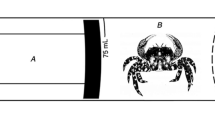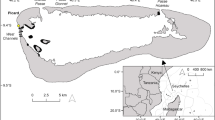Abstract
The potential contribution of early spring feeding conditions in the Arctic to clutch size variation was examined in a population of Lesser Snow Geese Anser caerulescens caerulescens. Behavioural observations were combined with energetic analyses of food material to derive an estimate of the energy budgets of pre-laying and laying females. Food intake of females between arrival on the breeding grounds and incubation was considerable; estimated energy gains in this period were in the same magnitude as the cost of one or several eggs. The pre-laying period spent on the breeding grounds can thus be energetically beneficial rather than costly. Accumulation of resources for reproduction in Snow Geese is a continual process including the breeding grounds, and nutrient limitation after arrival in the Arctic cannot sufficiently explain the environmental component of clutch size variation. The timing of migration and follicle development is such that clutch size decisions are sometimes made during the late stages of migration and some-times after arrival. In the latter case food conditions on the breeding grounds may greatly influence clutch size; in the former case they may still influence readjustments of clutch size after the initial decision. The universal negative correlation between clutch size and laying date in Snow Geese can be explained by negative fitness consequences of late hatching, which outweigh the benefits of delayed laying and further nutrient accumulation. Food shortage on the breeding grounds may sometimes be a secondary factor contributing to seasonal clutch size decline.
Similar content being viewed by others
References
Alisauskas RT, Ankney CD (1994) Costs and rates of egg formation in Ruddy Ducks. Condor 96: 11–18
Altmann J (1974) Observational studies of behavior: sampling methods. Behavior 49: 227–266
Ankney CD (1982) Annual cycle of body weight in Lesser Snow Geese. Wildl Soc Bull 10: 60–64
Ankney CD (1984) Nutrient reserve dynamics of breeding and molting Brant. Auk 101: 361–370
Ankney CD, MacInnes CD (1978) Nutrient reserves and reproductive performance of female lesser snow geese. Auk 95: 459–471
Astheimer LB, Grau CR (1990) A comparison of yolk growth rates in seabird eggs. Ibis 132: 380–394
Barry TW (1962) Effect of late season on Atlantic Brant reproduction. J Wildl Manage 26: 19–26
Bromley RG, Jarvis RL (1993) The energetics of migration and reproduction of Dusky Canada Geese. Condor 95: 193–210
Budeau DAJ, Ratti T, Ely CR (1991) Energy dynamics, foraging ecology, and behavior of pre-nesting Greater White-fronted Geese. J Wildl Manage 55: 556–563
Burton BA, Hudson RJ, Bragg DD (1979) Efficiency of utilization of Bulrush rhizomes by Lesser Snow Geese. J Wildl Manage 43: 728–735
Cooch EG, Lank DB, Rockwell RF, Cooke F (1989) Long term decline in fecundity in a snow goose population: evidence for density dependence? J Anim Ecol 58: 711–726
Cooch FG (1958) The breeding biology and management of the Blue Goose. PhD thesis, Cornell University, Ithaca
Cooke F, Findlay CS, Rockwell RF (1984) Recruitment and the timing of reproduction in Lesser Snow Geese. Auk 101: 451–458
Cooke F, Findlay CS, Rockwell RF, Smith JA (1985) Life history studies of the lesser snow goose. III. The selective value of plumage polymorphism: net fecundity. Evolution 39: 165–177
Cooke F, Rockwell RF, Lank DB (1995) The Snow Geese of La Pérouse Bay. Oxford University Press, Oxford
Drent RH, Daan S (1980) The prudent parent: energetic adjustments in avian breeding. Ardea 68: 225–252
Drent RH, Prins HHT (1987) The herbivore as prisoner of its food supply. In: Andel J, Prins HHT, Snaydon RW (eds). Disturbance in grasslands. Junk, Dordrecht
Drobney RD (1980) Reproductive bioenergetics of Wood Ducks. Auk 97:480–490
Ebbinge BS, St Joseph A, Prokosch P, Spaans B (1982) The importance of spring staging areas for Arctic-breeding geese, wintering in western Europe. Aquila 89: 249–258
Ely CR, Raveling DG (1984) Breeding biology of Pacific Whitefronted Geese. J Wildl Manage 48: 823–837
Gauthier G (1993) Feeding ecology of nesting Greater Snow Geese. J Wildl Manage 57: 216–223
Gauthier G, Tardif J (1991) Female feeding and male vigilance during nesting in Greater Snow Geese. Condor 93: 701–711
Gauthier G, Bédard J, Bédard Y (1984) Comparison of daily energy expenditure of Greater Snow Geese between two habitats. Can J Zool 62: 1304–1307
Gilbert AB (1971) The female reproductive effort. In: Bell DJ, Freeman BM (eds) Physiology and biochemistry of the domestic fowl, vol 3. Academic Press, London
Grau CR (1976) Ring structure of avian egg yolk. Poult Sci 55: 1418–1422
Hamann J (1983) Intraseasonal clutch size reduction in lesser snow geese. MSc thesis, Queen's University, Kingston
Hamann J, Cooke F (1989) Intra-seasonal decline in clutch size in lesser snow geese. Oecologia 79: 83–90
Hamann J, Andrews B, Cooke F (1986) The role of follicular atresia in inter- and intra-seasonal clutch size variation in lesser snow geese (Anser caerulescens caerulescens). J Anim Ecol 55: 481–489
Harvey JM (1971) Factors affecting blue goose nesting success. Can J Zool 49: 223–234
Hatchwell BJ, Pellatt J (1990) Intraspecific variation in egg composition and yolk formation in the common guillemot (Uria aalge). J Zool 220: 279–286
Hüppop O (1988) Aktivität und Energieumsatz bei Vögeln: Methoden und Ergebnisse. Seevögel 9: 95–106
Iacobelli A, Jefferies RL (1991) Inverse salinity gradients in coastal marshes and the death of stands of willow: the effects of grubbing by geese. J Ecol 79: 61–73
Jefferies RL, Jensen A, Abraham KF (1979) Vegetational development and the effect of geese on vegetation at La Pérouse Bay, Manitoba. Can J Bot 57: 1439–1450
Karasov WH (1990) Digestion in birds: chemical and physiological determinants and ecological implications. Stud Avian Biol 13: 391–415
Kerbes RH, Kotanen PM, Jefferies RL (1990) Destruction of wetland habitats by lesser snow geese: a keystone species on the west coast of Hudson Bay. J Appl Ecol 27: 42–258
Kersten M, Piersma T (1987) High levels of energy expenditure in shorebirds: metabolic adaptations to an energetically expensive way of life. Ardea 75: 175–187
Klomp H (1970) The determination of clutch size in birds: a review. Ardea 58: 1–124
Krapu GL, Reinecke KJ (1992) Foraging ecology and nutrition. In: Batt BDJ, Afton AD, Anderson MD, Ankney CD, Johnson DH, Kadlec JA, Krapu GL (eds) Ecology and management of breeding waterfowl. University of Minnesota Press, Minneapolis
Lasiewski RC, Dawson WR (1967) A re-examination of the relation between standard metabolic rate and body weight in birds. Condor 69: 13–23
Lefebvre EA, Raveling DG (1967) Distribution of Canada Geese in winter as related to heat loss at varying environmental temperatures. J Wildl Manage 31: 538–546
McLean JA, Tobin G (1987) Animal and human calorimetry. Cambridge University Press, Cambridge
Meathrel CE (1991) Variation in eggs and the period of rapid yolk deposition of the silver gull Larus novaehollandiae during a protracted laying season. J Zool 223: 501–508
Murton RK, Westwood NJ (1977) Avian breeding cycles. Clarendon Press, Oxford
Newton I (1977) Timing and success of breeding in tundra-nesting geese. In: Stonehouse B, Perrins C (eds) Evolutionary ecology. Macmillan, London
Owen M, Wells RL, Black JM (1992) Energy budgets of wintering Barnacle Geese: the effects of declining food resources. Ornis Scand 23: 451–458
Prop J, Vulink T (1992) Digestion by barnacle geese in the annual cycle: the interplay between retention time and food quality. Funct Ecol 6: 180–189
Raveling DG (1978) The timing of egg laying by northern geese. Auk 95: 294–303
Ronwer FC (1992) The evolution of reproductive patterns in waterfowl. In: Batt BDJ, Afton AD, Anderson MD, Ankney CD, Johnson DH, Kadlec JA, Krapu GL (eds) Ecology and management of breeding waterfowl. University of Minnesota Press, Minneapolis
Romanoff AL, Romanoff AJ (1949) The avian egg. Wiley, New York
Ryder JP (1970) A possible factor in the evolution of clutch size in Ross' Goose. Wilson Bull 82: 5–13
Ryder JP (1972) Biology of nesting Ross's Geese. Ardea 60: 185–215
Schubert CA, Cooke F (1993) Egg-laying intervals in the Lesser Snow Goose. Wilson Bull 105: 414–426
Sotherland PR, Rahn H (1987) On the composition of bird eggs. Condor 89: 48–65
Spaans B, Stock M, St Joseph A, Bergmann H-H, Ebbinge BS (1993) Breeding biology of dark-bellied brent geese Branta b. bernicla in Taimyr in 1990 in the absence of Arctic foxes and under favourable weather conditions. Polar Res 12: 117–130
Thomas VG (1983) Spring migration: the prelude to goose reproduction and a review of its implications. In: Boyd H (ed) First Western Hemisphere waterfowl and waterbird symposium. Canadian Wildlife Service, Ottawa
Thomas VG (1988) Body condition, ovarian hierarchies, and their relation to egg formation in Anseriform and Galliform species. Acta XIX Congressus Internationalis Ornithologici. Ottawa, Canada, pp 353–363
Tyler S (1979) Time sampling: a matter of convention. Anim Behav 27: 801–810
Williams TD, Cooch EG, Jefferies RL, Cooke F (1993a) Environmental degradation, food limitation and reproductive output: juvenile survival in lesser snow geese. J Anim Ecol 62: 766–777
Williams TD, Lank DB, Cooke F, Rockwell RF (1993b) Fitness consequences of egg-size variation in the lesser snow goose. Oecologia 96: 331–338
Wooley JB, Owen RB (1978) Energy costs of activity and daily energy expenditure in the Black Duck. J Wildl Manage 42: 739–745
Wypkema RCP, Ankney CD (1979) Nutrient reserve dynamics of lesser snow geese staging at James Bay, Ontario. Can J Zool 57: 213–219
Author information
Authors and Affiliations
Corresponding author
Rights and permissions
About this article
Cite this article
Ganter, B., Cooke, F. Pre-incubation feeding activities and energy budgets of Snow Geese: can food on the breeding grounds influence fecundity?. Oecologia 106, 153–165 (1996). https://doi.org/10.1007/BF00328594
Issue Date:
DOI: https://doi.org/10.1007/BF00328594




